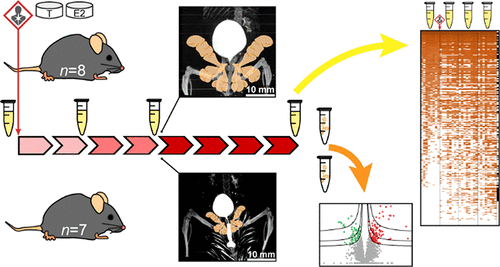当前位置:
X-MOL 学术
›
J. Proteome Res.
›
论文详情
Our official English website, www.x-mol.net, welcomes your feedback! (Note: you will need to create a separate account there.)
Spatiotemporal Proteomics Reveals the Molecular Consequences of Hormone Treatment in a Mouse Model of Lower Urinary Tract Dysfunction.
Journal of Proteome Research ( IF 4.4 ) Pub Date : 2020-03-16 , DOI: 10.1021/acs.jproteome.9b00451 Samuel Thomas 1 , Ling Hao 2 , Kellen DeLaney 3 , Dalton McLean 4 , Laura Steinke 2 , Paul C Marker 2 , Chad M Vezina 1, 5, 6 , Lingjun Li 1, 2, 3 , William A Ricke 1, 2, 4, 5
Journal of Proteome Research ( IF 4.4 ) Pub Date : 2020-03-16 , DOI: 10.1021/acs.jproteome.9b00451 Samuel Thomas 1 , Ling Hao 2 , Kellen DeLaney 3 , Dalton McLean 4 , Laura Steinke 2 , Paul C Marker 2 , Chad M Vezina 1, 5, 6 , Lingjun Li 1, 2, 3 , William A Ricke 1, 2, 4, 5
Affiliation

|
Benign prostatic hyperplasia and related lower urinary tract symptoms remain common, costly, and impactful issues for aging males. The etiology and pathogenesis are multifactorial and include steroid hormone changes and inflammation. Noninvasive markers could one day inform personalized medicine, but interindividual variation and lack of healthy age-matched controls hamper research. Experimental models are appealing for insight into disease mechanisms. Here, we present a spatiotemporal proteomics study in a mouse model of hormone-induced urinary dysfunction. Urine samples were collected noninvasively across time: before, during, and after disease onset. A microcomputed tomography analysis implicated the prostate as a spatially relevant contributor to bladder outlet obstruction. Prostates were collected after disease onset and compared with control mice. Notable changes in urine include proteins representing oxidative stress defense and acute phase inflammatory response processes. In the prostate, hormone treatment led to perturbations related to an oxidative stress response and H2O2 metabolism. Several protein changes coincided in both urine and the prostate tissue, including glutathione peroxidase 3, glutathione hydrolase 1 proenzyme, and vitamin D-binding protein. This study supports the concept of noninvasive urinary biomarkers for prostate disease diagnostics. Oxidative stress and acute phase inflammatory processes were identified as key consequences of hormone-induced bladder outlet obstruction. Future research into antioxidants and anti-inflammatories in prostate diseases appears promising.
中文翻译:

时空蛋白质组学揭示了下泌尿道功能障碍小鼠模型中激素治疗的分子后果。
良性前列腺增生症和相关的下尿路症状仍然是老年男性的常见,昂贵和有影响的问题。病因和发病机制是多因素的,包括类固醇激素变化和炎症。非侵入性标记可能有一天会告知个性化医学,但个体差异和缺乏与年龄匹配的健康对照会妨碍研究。实验模型吸引了人们对疾病机制的见识。在这里,我们目前在激素诱导的泌尿功能障碍的小鼠模型中时空蛋白质组学研究。在疾病发作之前,期间和之后,非侵入性地收集尿液样本。显微计算机断层扫描分析表明前列腺是膀胱出口梗阻的空间相关因素。在疾病发作后收集前列腺并与对照小鼠比较。尿液的显着变化包括代表氧化应激防御和急性期炎症反应过程的蛋白质。在前列腺中,激素治疗导致与氧化应激反应和H2O2代谢有关的摄动。尿液和前列腺组织中的几种蛋白质变化同时发生,包括谷胱甘肽过氧化物酶3,谷胱甘肽水解酶1酶和维生素D结合蛋白。该研究支持用于前列腺疾病诊断的非侵入性尿液生物标志物的概念。氧化应激和急性期炎症过程被确定为激素诱导的膀胱出口梗阻的关键后果。前列腺疾病中抗氧化剂和抗炎药的未来研究似乎很有希望。尿液的显着变化包括代表氧化应激防御和急性期炎症反应过程的蛋白质。在前列腺中,激素治疗导致与氧化应激反应和H2O2代谢有关的摄动。尿液和前列腺组织中的几种蛋白质变化同时发生,包括谷胱甘肽过氧化物酶3,谷胱甘肽水解酶1酶和维生素D结合蛋白。该研究支持用于前列腺疾病诊断的非侵入性尿液生物标志物的概念。氧化应激和急性期炎症过程被确定为激素诱导的膀胱出口梗阻的关键后果。前列腺疾病中抗氧化剂和抗炎药的未来研究似乎很有希望。尿液的显着变化包括代表氧化应激防御和急性期炎症反应过程的蛋白质。在前列腺中,激素治疗导致与氧化应激反应和H2O2代谢有关的摄动。尿液和前列腺组织中的几种蛋白质变化同时发生,包括谷胱甘肽过氧化物酶3,谷胱甘肽水解酶1酶和维生素D结合蛋白。该研究支持用于前列腺疾病诊断的非侵入性尿液生物标志物的概念。氧化应激和急性期炎症过程被确定为激素诱导的膀胱出口梗阻的关键后果。前列腺疾病中抗氧化剂和抗炎药的未来研究似乎很有希望。
更新日期:2020-02-28
中文翻译:

时空蛋白质组学揭示了下泌尿道功能障碍小鼠模型中激素治疗的分子后果。
良性前列腺增生症和相关的下尿路症状仍然是老年男性的常见,昂贵和有影响的问题。病因和发病机制是多因素的,包括类固醇激素变化和炎症。非侵入性标记可能有一天会告知个性化医学,但个体差异和缺乏与年龄匹配的健康对照会妨碍研究。实验模型吸引了人们对疾病机制的见识。在这里,我们目前在激素诱导的泌尿功能障碍的小鼠模型中时空蛋白质组学研究。在疾病发作之前,期间和之后,非侵入性地收集尿液样本。显微计算机断层扫描分析表明前列腺是膀胱出口梗阻的空间相关因素。在疾病发作后收集前列腺并与对照小鼠比较。尿液的显着变化包括代表氧化应激防御和急性期炎症反应过程的蛋白质。在前列腺中,激素治疗导致与氧化应激反应和H2O2代谢有关的摄动。尿液和前列腺组织中的几种蛋白质变化同时发生,包括谷胱甘肽过氧化物酶3,谷胱甘肽水解酶1酶和维生素D结合蛋白。该研究支持用于前列腺疾病诊断的非侵入性尿液生物标志物的概念。氧化应激和急性期炎症过程被确定为激素诱导的膀胱出口梗阻的关键后果。前列腺疾病中抗氧化剂和抗炎药的未来研究似乎很有希望。尿液的显着变化包括代表氧化应激防御和急性期炎症反应过程的蛋白质。在前列腺中,激素治疗导致与氧化应激反应和H2O2代谢有关的摄动。尿液和前列腺组织中的几种蛋白质变化同时发生,包括谷胱甘肽过氧化物酶3,谷胱甘肽水解酶1酶和维生素D结合蛋白。该研究支持用于前列腺疾病诊断的非侵入性尿液生物标志物的概念。氧化应激和急性期炎症过程被确定为激素诱导的膀胱出口梗阻的关键后果。前列腺疾病中抗氧化剂和抗炎药的未来研究似乎很有希望。尿液的显着变化包括代表氧化应激防御和急性期炎症反应过程的蛋白质。在前列腺中,激素治疗导致与氧化应激反应和H2O2代谢有关的摄动。尿液和前列腺组织中的几种蛋白质变化同时发生,包括谷胱甘肽过氧化物酶3,谷胱甘肽水解酶1酶和维生素D结合蛋白。该研究支持用于前列腺疾病诊断的非侵入性尿液生物标志物的概念。氧化应激和急性期炎症过程被确定为激素诱导的膀胱出口梗阻的关键后果。前列腺疾病中抗氧化剂和抗炎药的未来研究似乎很有希望。


























 京公网安备 11010802027423号
京公网安备 11010802027423号